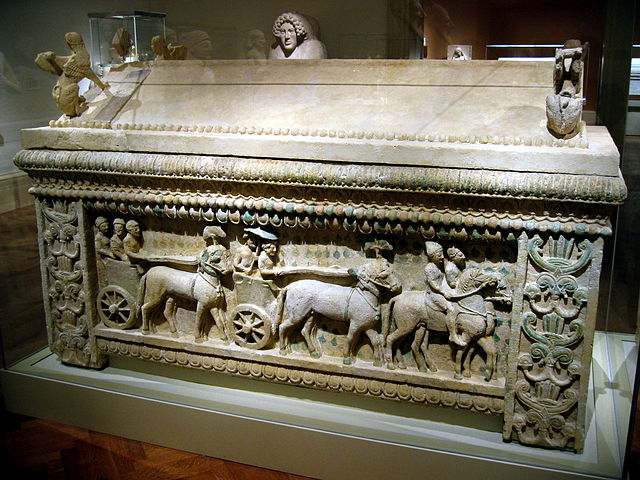
File:The 5th century BC Amathus sarcophagus.jpg

Size of this preview: 640 × 480 pixels.
| |
This is a file from the Wikimedia Commons. Information from its description page there is shown below.
Commons is a freely licensed media file repository. You can help. |
Summary
| Description |
English: Limestone sarcophagus: the Amathus sarcophagus, Sarcophagus, Amathus, 2nd quarter of the 5th century B.C.; Archaic period.
Cypriot Limestone; Overall: 62 x 93 1/8 x 38 1/2in. (157.5 x 236.6 x 97.8cm) The Amathus sarcophagus, from Amathus, Cyprus, arguably the single most important object in the Cesnola Collection, is unique among ancient Cypriot sculptures in its monumentality and in the preservation of its polychromy. It probably belonged to one of the kings of Amathus. The primary scenes, on the long sides, show a procession of chariots escorted by attendants on horseback and followed by foot soldiers. The main personage is probably the driver, who is standing under a parasol in the first chariot. His horses, like the others, are richly caparisoned; his chariot resembles the others as well, except that the wheel has fewer spokes. The decoration of the short ends of the sarcophagus consists of a row of Astarte figures, nude except for their double necklaces and ear caps, and a row of Bes figures. The choice of these two deities - one Near Eastern, the other Egyptian - suggests the importance of procreation to the deceased. The figural panels are framed by a variety of vegetal ornaments, while the gabled lid once featured a pair of sphinxes and a palmette at each end. The iconography as a whole documents the thorough integration of Greek, Cypriot, and Oriental features in the middle fifth century B.C. and is a work of high quality. (Metropolitan Museum of Art, NYC) |
|||||||||
| Date | 30 December 2005 | |||||||||
| Source | cyprus - coffin | |||||||||
| Author | Xuan Che | |||||||||
| Permission ( Reusing this file) |
|
File usage
The following pages on Schools Wikipedia link to this image (list may be incomplete):
Metadata
This file contains additional information, probably added from the digital camera or scanner used to create or digitize it. If the file has been modified from its original state, some details may not fully reflect the modified file.
| Camera manufacturer | Canon |
|---|---|
| Camera model | Canon DIGITAL IXUS 400 |
| Exposure time | 1/10 sec (0.1) |
| F-number | f/2.8 |
| Date and time of data generation | 18:31, 30 December 2005 |
| Lens focal length | 7.40625 mm |
| Orientation | Normal |
| Horizontal resolution | 72 dpi |
| Vertical resolution | 72 dpi |
| Software used | QuickTime 7.0.4 |
| File change date and time | 22:11, 14 January 2006 |
| Y and C positioning | Centered |
| Exif version | 2.2 |
| Date and time of digitizing | 18:31, 30 December 2005 |
| Image compression mode | 3 |
| Shutter speed | 3.3125 |
| APEX aperture | 2.96875 |
| Exposure bias | 0 |
| Maximum land aperture | 2.96875 APEX (f/2.8) |
| Metering mode | Pattern |
| Flash | Flash did not fire, compulsory flash suppression |
| Colour space | sRGB |
| Focal plane X resolution | 8,114.2857142857 |
| Focal plane Y resolution | 8,114.2857142857 |
| Focal plane resolution unit | inches |
| Sensing method | One-chip colour area sensor |
| Custom image processing | Normal process |
| Exposure mode | Auto exposure |
| White balance | Manual white balance |
| Digital zoom ratio | 1 |
| Scene capture type | Standard |
A background to Schools Wikipedia
Schools Wikipedia was created by children's charity SOS Children's Villages. SOS Children's Villages believes education is an important part of a child's life. That's why we ensure they receive nursery care as well as high-quality primary and secondary education. When they leave school, we support the children in our care as they progress to vocational training or higher education. Learn more about child sponsorship.
